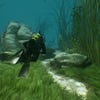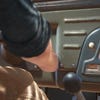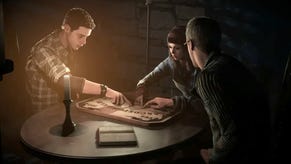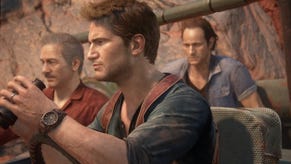Tech Analysis: Uncharted 4: A Thief's End
The technological powerhouse we've been waiting for.
The months prior to the launch of PlayStation 4 were filled with both excitement and rampant speculation - the likes of the now-cancelled Star Wars 1313 and Ubisoft's Watch Dogs hinted at what was to come, but the reality didn't quite live up to the promise. However, with the release of Uncharted 4: A Thief's End, we finally have a game that meets and exceeds our most optimistic pre-launch expectations. We've seen a number of current-gen consoles games delivering some remarkable visual achievements, but Naughty Dog has truly pushed on to the next level.
Simply put, Uncharted 4 is the technical powerhouse we've been waiting for. That fleeting sensation of being truly wowed by what's on-screen doesn't come quite as often as we like, but it's a feeling that never left us with this title - even as the final credits rolled. The set-pieces are more impressive, the maps larger, the characters and environments more detailed and the gameplay mechanics are richer than ever before. This is the real deal.
It's a game built on the most recent iteration of Naughty Dog's in-house engine technology, offering an almost obscene wealth of new rendering features, all while making life easier for its creators. Front-facing features include physically-based rendering, pre-computed global illumination, comprehensive physics simulation, superior artificial intelligence and more. The lineage from The Last of Us is certainly evident, but the more powerful PlayStation 4 hardware enables the team to push the scale of its ambition much further than any of its previous titles.
With such a complete package, it's difficult to fully appreciate everything being brought to the table by this game, but we've tried to break down the game into the key components that make it work so well, in addition to highlighting elements that don't quite match the overall sheen of the whole package.
What works
- Image quality: Uncharted 4 delivers the best image quality we've seen in a console game to date. Even in the face of rare titles like Tearaway Unfolded, with its high quality MSAA settings, Uncharted 4 stands tall. Naughty Dog has developed a temporal anti-aliasing technique that delivers results that sometimes manage to approach the quality of a super-sampled image. Thin edges are remarkably clean, shader aliasing is almost non-existent, and shimmering is all but eliminated. Large, complex fields of detailed foliage remain razor sharp even at a distance while finer details on Nate's weapons remain clearly visible. We noted similarities to the hybrid-reconstruction anti-aliasing used in Far Cry 4 but we cannot say for sure how this was achieved. Perhaps Naughty Dog will share more information on this in the future, as the results are stunning and this technique could benefit console games as a whole.
- Character rendering: This has become a very competitive field. Character rendering in many games including Halo 5, Quantum Break and Rise of the Tomb Raider has been remarkable, but Uncharted 4 pushes things even further. The quality of the characters is the result of excellent modelling, smart design and comprehensive engine features working in tandem. As a consequence of the physically-based approach used by the game, light properly reflects, refracts and penetrates the skin while micro-details help create that extra layer of realism. Skin and fat also bend and move realistically while details such as stubble, pupils and eyebrows are beautifully rendered in high fidelity. Beyond that, clothing is also taken into account as part of the simulation, such as the way Drake's shirt reacts to the wind simulation or how his tools bounce around as he runs. Even his chest hair is impacted by the wind. Speaking of hair, the quality across the game is exceptional with a complex assortment of textured cards giving the impression of real strands of hair. It's not simulated in as much detail as the impressive TressFX system featured in Rise of the Tomb Raider, but it's more consistent across all characters.
- Character performance: Another key element in bringing Uncharted to life lies in its animation and character performance. The animation techniques used in the game have evolved greatly, offering enhanced layering alongside a greater number of available animations in general. Drake has a real weight previously lacking in the series - which actually has a positive impact on the controls. Facial animation has improved with more than 850 possible expressions now available compared to Uncharted 3's 120. Character faces use all of the muscles in the head and neck to great effect and Naughty Dog's mix of captured and hand-created animation work is convincing. During cut-scenes, the smallest nuances are captured in the character's performances, helping to deliver the story - which brings us to our next point.
- Real-time cut-scenes: One of the most profound shifts in the series over previous entries is the move to real-time cut-scenes. Previously, the complexity of the cinematics necessitated the use of pre-rendered video files. This helps conceal loading at points but also lightens the load on the hardware. Moving to real-time creates a more cohesive presentation, with the game now able to transition seamlessly between gameplay and cinematics. It also makes for a convincing tech demo as the visuals on display here are some of the most impressive we've seen to date. More impressively, the final game comes very close to matching the quality of the original E3 2014 teaser trailer - something we'll be exploring this week.
- Environments: Naughty Dog has poured a lot of effort into the game's environments by making certain that they are more interactive and visually dense. A wind system is implemented, enabling the artists to set values for intensity and speed that directly impact the world. Grass and trees blow realistically: pools of water exhibit the expected response. The way in which the environment interacts with Nate is impressive as well. Stand below a source of running water and marvel as it seeps realistically into his shirt - wetness is no longer a simple on or off state. Dirt and mud decals also collect on characters and objects while water can wash it away. All of these elements come together to more firmly ground Nate and friends into the environment.
- Materials and textures: This generation has been defined by the use of physically-based materials and Uncharted 4 is our first look at Naughty Dog's implementation. Uncharted 4 retains the series' stylised look, which isn't quite photorealistic, but certainly comes close at times. The way lighting plays off of elements such as stone work and foliage feels very natural here. We were also impressed with the inclusion of parallax occlusion maps in various areas of the game. Bricks and roof tiles exhibit actual depth as a result. It's also surprising to see just how quickly and efficiently these assets are loaded. Texture pop-in is uncommon as well, with only the occasional late normal map popping up. The engine seems very capable of working with a huge variety of assets at a high speed - something which no doubt factors into the game's ability to display cut-scenes in real-time.
- Audio: Naughty Dog has been producing games in 7.1 surround for a decade now but the audio mix in Uncharted 4 is a real treat. There is a lot of processing happening with the audio to produce realistic results in a variety of environments. The sound of a character's voice will change based on your proximity and location. If you stand in a cave next to Sully, for instance, his voice sounds different depending on whether he's in the same area of the cave as Nate. The same applies to other sound effects. Overall audio mixing is also top notch while the game's musical score is able to seamlessly weave in and out of the action dynamically.
- Artificial Intelligence: One of the most profound improvements to the core gameplay experience stems from the enhanced AI systems. To start with, the companion AI is a refinement of what we saw with Elli in The Last of Us. This time around, Naughty Dog introduces multiple partners, aiding the player in dispatching foes at opportune moments without ever feeling scripted. Crucially, the enemy AI is also dramatically overhauled. In the past, once spotted, enemies would remain active and aware of your position until they were dispatched, leading to plenty of one-note battles and failed stealth attempts. Now, enemies are capable of patrolling large chunks of the map and forming groups all while exhibiting an appropriate grey area - the area which defines its awareness of the player. The general behaviour now shares more with games such as Metal Gear Solid or, of course, The Last of Us, to the point where it becomes enjoyable to simply toy with the AI. There are still moments in the game in which full-on gun battles break out, leaving the player with little choice but to engage. However, the general combat experience offers so many new tactical options that it manages to feel fresh right up until the end of the game.
- Screen-space reflections: This type of reflection technique has become increasingly popular in modern games due to its efficiency and quality. But it has a limitation - as the name implies, it relies on information within screen-space to achieve the desired effect. When the objects reflected are occluded from view, the game no longer has information necessary for the reflections. Uncharted 4 uses a mix of approximate pre-calculated reflections, such as cube-maps, and screen-space reflections. As characters are occluded from view and the screen-space reflection is removed from the screen, we see another technique take over. What appears to be some sort of shadow lies beneath the screen-space reflection so as the high-quality reflection is removed from view, there is something else in its place.
- Light shafts: Naughty Dog has been focused on delivering convincing volumetric light shafts for years now and we're seeing the latest iteration of those techniques here. Many games still resort to screen-space light shafts, but the approach here enables the light source to disappear from view while the volumetric shaft remains visible. This technique is used both for environment lighting and lighting attached to characters, such as a flashlight beam.
- Asset variety: Asset creation is a huge bottleneck in game development today, often requiring cooperation of multiple supporting studios, but Uncharted 4 features a level of variety to the assets that we don't often see. The push towards sandbox games typically means that assets are more homogenised but Uncharted 4 presents a huge number of locales at high levels of detail. There are a huge number of one-off areas and environments where you ultimately spend very little time, but the level of detail is consistent. A large budget certainly helps but it's clear that the asset creation process was handled very efficiently here.
- Water: Water has always played a significant role in the Uncharted series and the latest game presents a number of improvements. The simulation of turbulent water has evolved from Uncharted 3 with more complex wave patterns now possible, while even more tranquil bodies of water are influenced by the wind simulation. Along those lines, we were impressed by the way shadows fall on shallow, muddy waters. It appears that Naughty Dog uses motion vector data to give the impression of shadows intersecting with the water naturally. It's just another example of the attention to detail on display here.
What doesn't work
- Loading: While the game is a seamless experience during a normal playthrough, anyone attempting to replay the game or experiment with different sequences will quickly run into very lengthy loading screens. Selecting any encounter or chapter requires a solid minute of loading, which is frustrating enough, but manually resetting to a previous checkpoint requires just as much waiting. In attempting to capture footage for the game, this quickly became frustrating, but even for users looking to perfect their run, it could become a chore.
- Photo mode: We certainly appreciate the inclusion of photo mode here but it doesn't feel quite finished. The primary issue centres on the fact that the camera remains locked to the playable character, without the ability to freely move about the environment. The camera is also locked in place when pausing during cut-scenes. Now, we understand the reasoning behind this decision, but it would be interesting to have greater control over this feature. After all, the frame-rate takes a dive while in photo mode as it is, so other side effects from manipulating the camera surely wouldn't be an issue. The Order 1886 allows users to fly the camera freely around every stage in the game - it would have been nice to see it here as well.
- Shadow quality: Shadows are computationally expensive and, truthfully, Uncharted does a mostly good job of rendering them but there are a number of scenes where artefacts shine through, revealing rather pixelated results. We also noticed artefacts when objects pass in front of certain surfaces - a ghosting of sorts.
- The E3 2014 60fps promise: Not so much something that doesn't work, as opposed to an initial promise that didn't work out. It's pretty clear that the visuals on display in Uncharted 4 would be impossible at a full 60fps - likely due in part to the limited CPU used in the PlayStation 4 - but some fans remain affected and disappointed by the original promises of a 60fps experience. Releasing that original E3 2014 teaser trailer at a full 60fps means that as impressive as the game is, there are still those that will be disappointed. Unfortunately, this is the reality of game development. After all, both Uncharted 4 and Halo 5 were initially targeting 1080p60. Naughty Dog opted to drop the frame-rate for the campaign while sticking with 1080p while 343 Industries sacrificed resolution for a rock solid 60fps at all times. At least the game's multiplayer mode delivers 60fps even if the resolution has been dropped to 900p. We'll be testing that soon - the servers were offline during production of this article.
Uncharted 4: A Thief's End - the Digital Foundry verdict
Uncharted 4 delivers a genuine step advance in real-time rendering on console hardware. The Naughty Dog engine is an efficient, capable engine that produces results that tower above many other current generation titles. There is a clear dedication to excellence here and it has paid off and Uncharted 4 is the best-looking console game we've ever tested. There are some titles which come close in certain areas, such as the remarkably impressive Star Wars Battlefront, but nothing is as polished and consistent as Naughty Dog's latest.
Even more impressively, the technology isn't simply used for delivering pretty visuals. We've seen similarly beautiful results on consoles with games such as The Order 1886 and Ryse, which were fun but very narrow experiences. Uncharted 4 excels in presenting an unprecedented level of detail while actually expanding the core gameplay. Seeing both visuals and game design evolve and expand in one package is a rare treat indeed.
With all the recent talk about the PlayStation Neo, Uncharted 4 demonstrates just how much can still be achieved on less powerful hardware. It's clear that many developers lack the budget and staff necessary to pull this off, but it's always fascinating to see what can be achieved at the high-end. The question that remains is where we go from here. The original Uncharted represented Naughty Dog's first foray into the world of programmable pixel shaders and the team was able to iterate beautifully between each game. It's difficult to predict what kind of results we'll see in its next game but we're certainly excited about the future.
Still, in many ways, the future is now and there is no better showcase for what can be achieved on console than Uncharted 4. This is a must-play experience that delivers the rare mix of pitch perfect gameplay and high-end visuals. If you've been keeping up with Digital Foundry over the years and have an interest in graphics technology, you owe it to yourself to give Uncharted 4 a try. In fact, it's such a remarkable achievement that even users that prefer to stick with other platforms should find a way to at least sample the game, just to appreciate the extreme artistry and expertise on display here.
For more on Naughty Dog's latest, check out our Uncharted 4 guide and walkthrough.




























